An Overview of Smart Composites for the Aerospace Sector
Abstract
1. Introduction
2. Materials and Methods
3. Results
3.1. Document Collection
3.2. Annual Published Documents and Citations
3.3. Scientific Journals
3.4. Authors
3.5. Affiliations and Countries
3.6. Publications Analysis
4. Discussion
4.1. Trends in Top Publications
4.2. Keywords Trends
4.3. Thematic Map
4.4. Topic Analysis
4.5. Aerospace Applications of Smart Composites
5. Conclusions
Author Contributions
Funding
Data Availability Statement
Conflicts of Interest
Abbreviations
| SHM | Structural health monitoring |
| EMI | Electromagnetic interference |
| TC | Total citations |
| NP | Number of publications |
| UAS | Unmanned aerial system |
References
- Soni, R.; Verma, R.; Kumar Garg, R.; Sharma, V. A Critical Review of Recent Advances in the Aerospace Materials. Mater. Today Proc. 2024, 113, 180–184. [Google Scholar] [CrossRef]
- Prakash, V.R.A.; Bourchak, M.; Alshahrani, H.; Juhany, K.A. Synthesis and Characterization of Lightweight Unmanned Aerial Vehicle Composite Building Material for Defense Application. Biomass Convers. Biorefin. 2023, 14, 31895–31906. [Google Scholar] [CrossRef]
- Kontiza, A.; Kartsonakis, I.A. Smart Composite Materials with Self-Healing Properties: A Review on Design and Applications. Polymers 2024, 16, 2115. [Google Scholar] [CrossRef] [PubMed]
- Beziuk, G.; Krajewski, A.; Baum, T.C.; Nicholson, K.J.; Ghorbani, K. Electromagnetic and Electronic Aerospace Conformal Load-Bearing Smart Skins: A Review. IEEE J. Microw. 2024, 4, 13–42. [Google Scholar] [CrossRef]
- Ferreira, A.D.B.L.; Nóvoa, P.R.O.; Marques, A.T. Multifunctional Material Systems: A State-of-the-Art Review. Compos. Struct. 2016, 151, 3–35. [Google Scholar] [CrossRef]
- Simões, S. High-Performance Advanced Composites in Multifunctional Material Design: State of the Art, Challenges, and Future Directions. Materials 2024, 17, 5997. [Google Scholar] [CrossRef]
- Abbas, S.; Li, F.; Qiu, J. A Review on SHM Techniques and Current Challenges for Characteristic Investigation of Damage in Composite Material Components of Aviation Industry. Mater. Perform. Charact. 2018, 7, 224–258. [Google Scholar] [CrossRef]
- Bouhamed, A.; Binyu, Q.; Böhm, B.; Jöhrmann, N.; Behme, N.; Goedel, W.A.; Wunderle, B.; Hellwig, O.; Kanoun, O. A Hybrid Piezoelectric Composite Flexible Film Based on PVDF-HFP for Boosting Power Generation. Compos. Sci. Technol. 2021, 208, 108769. [Google Scholar] [CrossRef]
- Šišovas, L.; Čeponis, A.; Borodinas, S. The Challenges of Piezoelectric Actuators and Motors Application in a Space Environment. Actuators 2024, 13, 312. [Google Scholar] [CrossRef]
- del Bosque, A.; Sánchez-Romate, X.F.; Sánchez, M.; Ureña, A. Flexible Wearable Sensors Based in Carbon Nanotubes Reinforced Poly(Ethylene Glycol) Diglycidyl Ether (PEGDGE): Analysis of Strain Sensitivity and Proof of Concept. Chemosensors 2021, 9, 158. [Google Scholar] [CrossRef]
- Spahr, M.E.; Gilardi, R.; Bonacchi, D. Carbon Black for Electrically Conductive Polymer Applications. In Fillers for Polymer Applications. Polymers and Polymeric Composites: A Reference Series; Springer: Cham, Switzerland, 2017; pp. 375–400. [Google Scholar] [CrossRef]
- Liu, H.; Li, Q.; Zhang, S.; Yin, R.; Liu, X.; He, Y.; Dai, K.; Shan, C.; Guo, J.; Liu, C.; et al. Electrically Conductive Polymer Composites for Smart Flexible Strain Sensors: A Critical Review. J. Mater. Chem. C Mater. 2018, 6, 12121–12141. [Google Scholar] [CrossRef]
- Yu, Q.; Ge, R.; Wen, J.; Du, T.; Zhai, J.; Liu, S.; Wang, L.; Qin, Y. Highly Sensitive Strain Sensors Based on Piezotronic Tunneling Junction. Nat. Commun. 2022, 13, 778. [Google Scholar] [CrossRef] [PubMed]
- Song, P.; Cai, Z.; Li, J.; He, M.; Qiu, H.; Ren, F.; Zhang, Y.; Guo, H.; Ren, P. Construction of RGO-MXene@FeNi/Epoxy Composites with Regular Honeycomb Structures for High-Efficiency Electromagnetic Interference Shielding. J. Mater. Sci. Technol. 2025, 217, 311–320. [Google Scholar] [CrossRef]
- Gao, Q.; Wang, X.; Schubert, D.W.; Liu, X. Review on Polymer/MXene Composites for Electromagnetic Interference Shielding Applications. Adv. Nanocompos. 2024, 1, 52–76. [Google Scholar] [CrossRef]
- Suchea, M.; Tudose, I.V.; Pascariu, P.; Koudoumas, E. Carbon-Based Nanocomposites for EMI Shielding: Recent Advances. In Materials for Potential EMI Shielding Applications: Processing, Properties and Current Trends; Elsevier: Amsterdam, The Netherlands, 2020; pp. 201–211. [Google Scholar] [CrossRef]
- Dehghani-Dashtabi, M.; Hekmatara, H. Structural, Electrical and EMI Shielding Property of Carbon Nanotube Decorated Magnetic/Ceramic Nanoparticles. Sci. Rep. 2025, 15, 1311. [Google Scholar] [CrossRef]
- Del Bosque, A.; Calderón-Villajos, R.; Sánchez, M.; Ureña, A. Multifunctional Carbon Nanotubes-Reinforced Surlyn Nanocomposites: A Study of Strain-Sensing and Self-Healing Capabilities. Nanomaterials 2022, 12, 2878. [Google Scholar] [CrossRef]
- Zhang, Z.; Gao, Z.; Wang, Y.; Guo, L.; Yin, C.; Zhang, X.; Hao, J.; Zhang, G.; Chen, L. Eco-Friendly, Self-Healing Hydrogels for Adhesive and Elastic Strain Sensors, Circuit Repairing, and Flexible Electronic Devices. Macromolecules 2019, 52, 2531–2541. [Google Scholar] [CrossRef]
- Liu, Y.; Wei, X.; He, X.; Yao, J.; Tan, R.; Chen, P.; Yao, B.; Zhou, J.; Yao, Z.; Liu, Y.; et al. Multifunctional Shape Memory Composites for Joule Heating, Self-Healing, and Highly Efficient Microwave Absorption. Adv. Funct. Mater. 2023, 33, 2211352. [Google Scholar] [CrossRef]
- Nadzharyan, T.A.; Shamonin, M.; Kramarenko, E.Y. Theoretical Modeling of Magnetoactive Elastomers on Different Scales: A State-of-the-Art Review. Polymers 2022, 14, 4096. [Google Scholar] [CrossRef]
- Haddaway, N.R.; Page, M.J.; Pritchard, C.C.; McGuinness, L.A. PRISMA2020: An R Package and Shiny App for Producing PRISMA 2020-Compliant Flow Diagrams, with Interactivity for Optimised Digital Transparency and Open Synthesis. Campbell Syst. Rev. 2022, 18, e1230. [Google Scholar] [CrossRef]
- Page, M.J.; McKenzie, J.E.; Bossuyt, P.M.; Boutron, I.; Hoffmann, T.C.; Mulrow, C.D.; Shamseer, L.; Tetzlaff, J.M.; Akl, E.A.; Brennan, S.E.; et al. The PRISMA 2020 Statement: An Updated Guideline for Reporting Systematic Reviews. Int. J. Surg. 2021, 88, 105906. [Google Scholar] [CrossRef] [PubMed]
- del Bosque, A.; Lampropoulos, G.; Vergara, D. Nanocomposites for Multifunctional Sensors: A Comprehensive Bibliometric Exploration. Nanomaterials 2024, 15, 34. [Google Scholar] [CrossRef] [PubMed]
- Aria, M.; Cuccurullo, C. Bibliometrix: An R-Tool for Comprehensive Science Mapping Analysis. J. Inf. 2017, 11, 959–975. [Google Scholar] [CrossRef]
- Liu, J.; Zhang, H.B.; Sun, R.; Liu, Y.; Liu, Z.; Zhou, A.; Yu, Z.Z. Hydrophobic, Flexible, and Lightweight MXene Foams for High-Performance Electromagnetic-Interference Shielding. Adv. Mater. 2017, 29, 1702367. [Google Scholar] [CrossRef]
- Khoo, Z.X.; Teoh, J.E.M.; Liu, Y.; Chua, C.K.; Yang, S.; An, J.; Leong, K.F.; Yeong, W.Y. 3D Printing of Smart Materials: A Review on Recent Progresses in 4D Printing. Virtual Phys. Prototyp. 2015, 10, 103–122. [Google Scholar] [CrossRef]
- Ma, Z.; Kang, S.; Ma, J.; Shao, L.; Zhang, Y.; Liu, C.; Wei, A.; Xiang, X.; Wei, L.; Gu, J. Ultraflexible and Mechanically Strong Double-Layered Aramid Nanofiber-Ti3C2TxMXene/Silver Nanowire Nanocomposite Papers for High-Performance Electromagnetic Interference Shielding. ACS Nano 2020, 14, 8368–8382. [Google Scholar] [CrossRef]
- Lum, G.Z.; Ye, Z.; Dong, X.; Marvi, H.; Erin, O.; Hu, W.; Sitti, M. Shape-Programmable Magnetic Soft Matter. Proc. Natl. Acad. Sci. USA 2016, 113, E6007–E6015. [Google Scholar] [CrossRef]
- Wei, H.; Zhang, Q.; Yao, Y.; Liu, L.; Liu, Y.; Leng, J. Direct-Write Fabrication of 4D Active Shape-Changing Structures Based on a Shape Memory Polymer and Its Nanocomposite. ACS Appl. Mater. Interfaces 2017, 9, 876–883. [Google Scholar] [CrossRef]
- Mu, Q.; Wang, L.; Dunn, C.K.; Kuang, X.; Duan, F.; Zhang, Z.; Qi, H.J.; Wang, T. Digital Light Processing 3D Printing of Conductive Complex Structures. Addit. Manuf. 2017, 18, 74–83. [Google Scholar] [CrossRef]
- Wan, Y.J.; Zhu, P.L.; Yu, S.H.; Sun, R.; Wong, C.P.; Liao, W.H. Anticorrosive, Ultralight, and Flexible Carbon-Wrapped Metallic Nanowire Hybrid Sponges for Highly Efficient Electromagnetic Interference Shielding. Small 2018, 14, 1800534. [Google Scholar] [CrossRef]
- Fan, Z.; Wang, D.; Yuan, Y.; Wang, Y.; Cheng, Z.; Liu, Y.; Xie, Z. A Lightweight and Conductive MXene/Graphene Hybrid Foam for Superior Electromagnetic Interference Shielding. Chem. Eng. J. 2020, 381, 122696. [Google Scholar] [CrossRef]
- Jain, A.; Prashanth, K.J.; Sharma, A.K.; Jain, A.; Pn, R. Dielectric and Piezoelectric Properties of PVDF/PZT Composites: A Review. Polym. Eng. Sci. 2015, 55, 1589–1616. [Google Scholar] [CrossRef]
- Guo, F.; Jiang, Y.; Xu, Z.; Xiao, Y.; Fang, B.; Liu, Y.; Gao, W.; Zhao, P.; Wang, H.; Gao, C. Highly Stretchable Carbon Aerogels. Nat. Commun. 2018, 9, 881. [Google Scholar] [CrossRef] [PubMed]
- Vo, T.V.K.; Lubecki, T.M.; Chow, W.T.; Gupta, A.; Li, K.H.H. Large-Scale Piezoelectric-Based Systems for More Electric Aircraft Applications. Micromachines 2021, 12, 140. [Google Scholar] [CrossRef]
- Xu, T.B. Energy Harvesting Using Piezoelectric Materials in Aerospace Structures. In Structural Health Monitoring (SHM) in Aerospace Structures; Woodhead Publishing: Cambridge, UK, 2016; pp. 175–212. [Google Scholar] [CrossRef]
- Bakhtar, L.J.; Abdoos, H.; Rashidi, S. A Review on Fabrication and in Vivo Applications of Piezoelectric Nanocomposites for Energy Harvesting. J. Taiwan Inst. Chem. Eng. 2023, 148, 104651. [Google Scholar] [CrossRef]
- Andreades, C.; Mahmoodi, P.; Ciampa, F. Characterisation of Smart CFRP Composites with Embedded PZT Transducers for Nonlinear Ultrasonic Applications. Compos. Struct. 2018, 206, 456–466. [Google Scholar] [CrossRef]
- Xu, F.; Zhang, S.Q.; Xu, C.; Ruan, D.; Li, B.; Gao, Y.F.; Ma, C.G.; Gao, J.F. The Effect of Electrical Anisotropy on Delamination Detection Sensitivity for Structural Health Monitoring of Laminated Composites. Compos. Struct. 2024, 347, 118463. [Google Scholar] [CrossRef]
- del Bosque, A.; Sánchez-Romate, X.F.; Sánchez, M.; Ureña, A. Toward Flexible Piezoresistive Strain Sensors Based on Polymer Nanocomposites: A Review on Fundamentals, Performance, and Applications. Nanotechnology 2024, 35, 292003. [Google Scholar] [CrossRef]
- Hsu, M.K.; Chen, W.; Huang, B.Y.; Shen, L.H.; Hsu, C.H.; Chang, R.Y.; Yu, C.H. A Deep Learning Empowered Smart Representative Volume Element Method for Long Fiber Woven Composites. Front. Mater. 2023, 10, 1179710. [Google Scholar] [CrossRef]
- Wang, W.; Xiang, Y.; Yu, J.; Yang, L. Development and Prospect of Smart Materials and Structures for Aerospace Sensing Systems and Applications. Sensors 2023, 23, 1545. [Google Scholar] [CrossRef]
- Ogunleye, R.O.; Rusnáková, S.; Javořík, J.; Žaludek, M.; Kotlánová, B. Advanced Sensors and Sensing Systems for Structural Health Monitoring in Aerospace Composites. Adv. Eng. Mater. 2024, 26, 2401745. [Google Scholar] [CrossRef]
- Ahmed, O.; Wang, X.; Tran, M.V.; Ismadi, M.Z. Advancements in Fiber-Reinforced Polymer Composite Materials Damage Detection Methods: Towards Achieving Energy-Efficient SHM Systems. Compos. B Eng. 2021, 223, 109136. [Google Scholar] [CrossRef]
- del Bosque, A.; Sánchez-Romate, X.F.; Sánchez, M.; Ureña, A. Ultrasensitive and Highly Stretchable Sensors for Human Motion Monitoring Made of Graphene Reinforced Polydimethylsiloxane: Electromechanical and Complex Impedance Sensing Performance. Carbon. N. Y. 2022, 192, 234–248. [Google Scholar] [CrossRef]
- Hashemi, R.; Weng, G.J. A Theoretical Treatment of Graphene Nanocomposites with Percolation Threshold, Tunneling-Assisted Conductivity and Microcapacitor Effect in AC and DC Electrical Settings. Carbon. N. Y. 2016, 96, 474–490. [Google Scholar] [CrossRef]
- Kaynan, O.; Atescan, Y.; Ozden-Yenigun, E.; Cebeci, H. Mixed Mode Delamination in Carbon Nanotube/Nanofiber Interlayered Composites. Compos. B Eng. 2018, 154, 186–194. [Google Scholar] [CrossRef]
- Rafiee, R.; Sahraei, M. Characterizing Delamination Toughness of Laminated Composites Containing Carbon Nanotubes: Experimental Study and Stochastic Multi-Scale Modeling. Compos. Sci. Technol. 2021, 201, 108487. [Google Scholar] [CrossRef]
- Iorio, L.; Bellisario, D.; Quadrini, F. Manufacturing and Testing of Shape Memory Polymer Composite Actuators. In Selected Topics in Manufacturing—Lecture Notes in Mechanical Engineering; Springer: Cham, Switzerland, 2024; Part F1351; pp. 141–157. [Google Scholar] [CrossRef]
- Li, Y.; Lau, D. Advances in Shape Memory Polymers and Their Composites: From Theoretical Modeling and MD Simulations to Additive Manufacturing. Giant 2024, 18, 100277. [Google Scholar] [CrossRef]
- Huang, C.; Yang, C.; Wang, S.; Wu, W.; Su, J.; Liang, C. Evolution of Topics in Education Research: A Systematic Review Using Bibliometric Analysis. Educ. Rev. 2020, 72, 281–297. [Google Scholar] [CrossRef]
- Trýb, J.; Hospodka, J. GNSS Interference and Security: Impacts on Critical Infrastructure and Mitigation Strategies. Procedia Comput. Sci. 2025, 253, 2635–2644. [Google Scholar] [CrossRef]
- He, Y.; Li, B.; Chen, J.; Wang, Z.; Xiao, W.; Lu, Z. Overview of the Development of Satellite Navigation Blanket Interference Monitoring. Front. Phys. 2024, 12, 1487384. [Google Scholar] [CrossRef]
- Zhang, Z.; Zhou, Y.; Zhang, Y.; Qian, B. Strong Electromagnetic Interference and Protection in UAVs. Electronics 2024, 13, 393. [Google Scholar] [CrossRef]
- Duigou, A.L.; Grabow, M.; Scarpa, F.; Deschamps, J.; Combescure, C.; Labstie, K.; Dirrenberger, J.; Castro, M.; Lafont, U. Bioinspired 4D Printed Tubular/Helicoidal Shape Changing Metacomposites for Programmable Structural Morphing. Adv. Mater. Technol. 2025, 10, 2400237. [Google Scholar] [CrossRef]
- Kostopoulos, G.; Stamoulis, K.; Lappas, V.; Georgantzinos, S.K. Shape Morphing of 4D-Printed Polylactic Acid Structures under Thermal Stimuli: An Experimental and Finite Element Analysis. Aerospace 2024, 11, 134. [Google Scholar] [CrossRef]
- Zhang, Y.; Radzieński, M.; Ostachowicz, W. Diagnostic-Prognostic Framework for Assessing the Health Status of Composite Structures. Int. J. Mech. Sci. 2024, 278, 109461. [Google Scholar] [CrossRef]
- Kosova, F.; Altay, Ö.; Ünver, H.Ö. Structural Health Monitoring in Aviation: A Comprehensive Review and Future Directions for Machine Learning. Nondestruct. Test. Eval. 2025, 40, 1–60. [Google Scholar] [CrossRef]
- Le, T.C.; Luu, T.H.T.; Nguyen, H.P.; Nguyen, T.H.; Ho, D.D.; Huynh, T.C. Piezoelectric Impedance-Based Structural Health Monitoring of Wind Turbine Structures: Current Status and Future Perspectives. Energies 2022, 15, 5459. [Google Scholar] [CrossRef]
- Martinez-Luengo, M.; Kolios, A.; Wang, L. Structural Health Monitoring of Offshore Wind Turbines: A Review through the Statistical Pattern Recognition Paradigm. Renew. Sustain. Energy Rev. 2016, 64, 91–105. [Google Scholar] [CrossRef]
- Firoozi, A.A.; Firoozi, A.A.; El-Abbasy, A.A.; Aati, K. Enhanced Perspectives on Silica Aerogels: Novel Synthesis Methods and Emerging Engineering Applications. Results Eng. 2025, 25, 103615. [Google Scholar] [CrossRef]
- Jin, R.; Zhou, Z.; Liu, J.; Shi, B.; Zhou, N.; Wang, X.; Jia, X.; Guo, D.; Xu, B. Aerogels for Thermal Protection and Their Application in Aerospace. Gels 2023, 9, 606. [Google Scholar] [CrossRef]






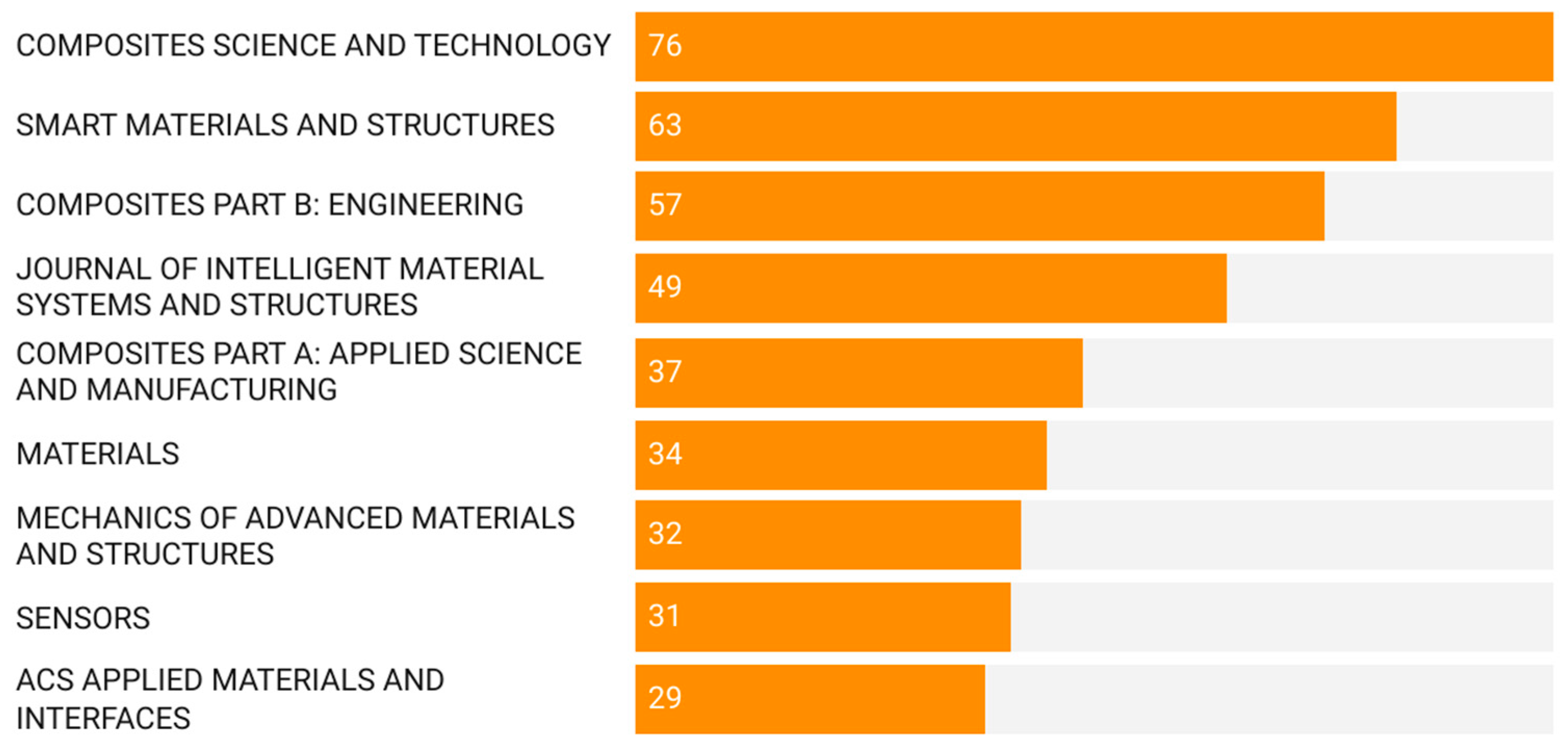
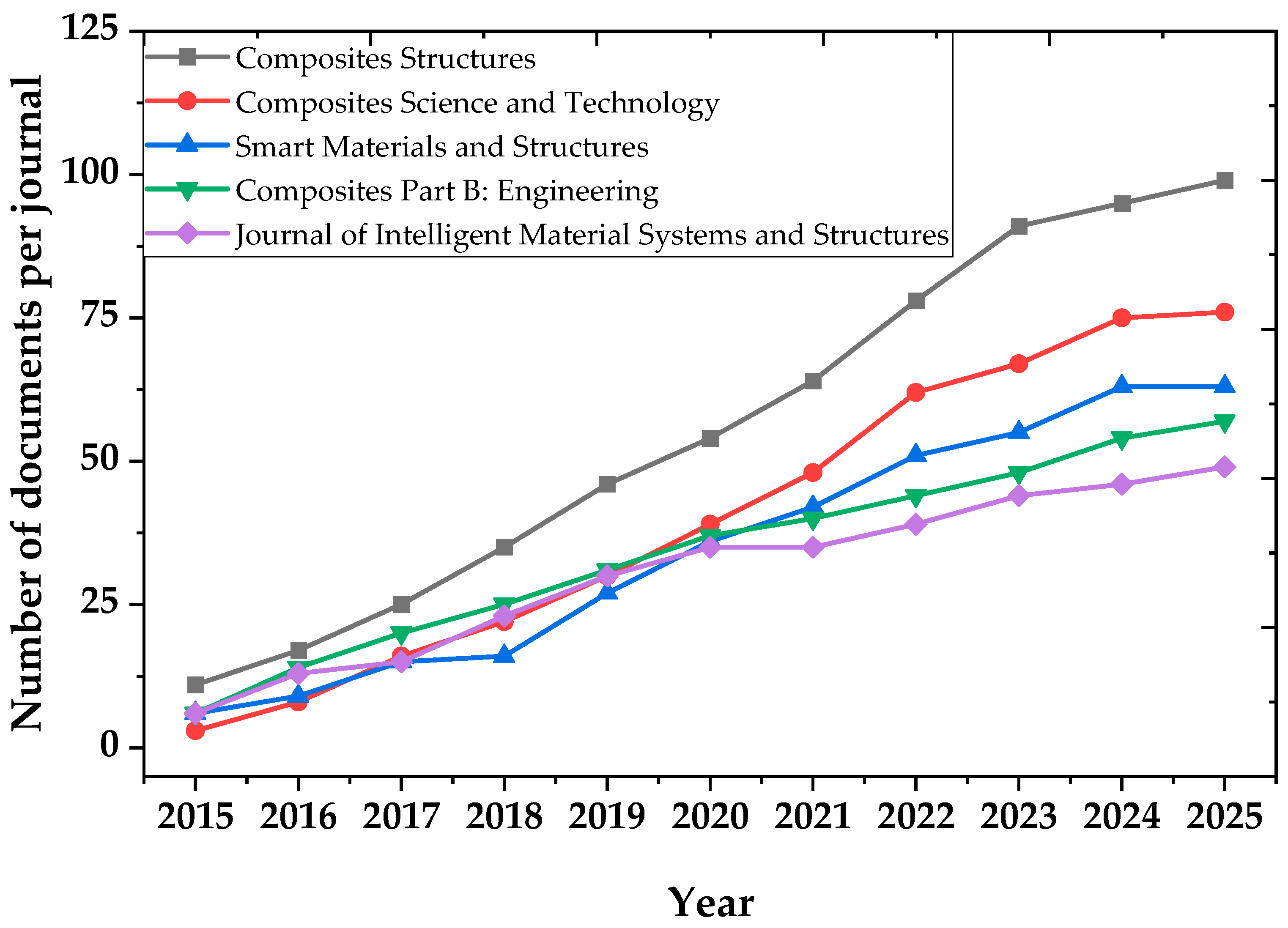
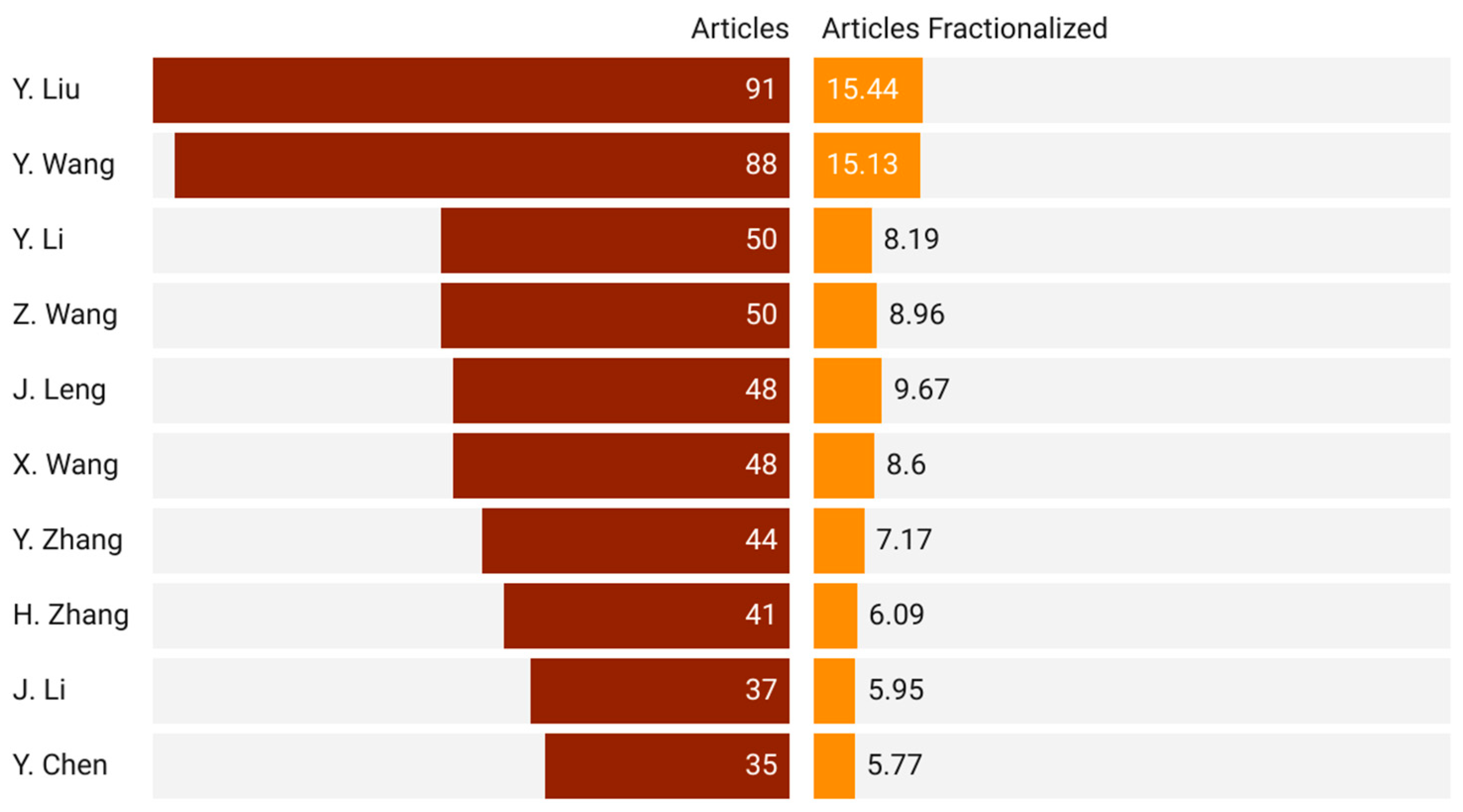

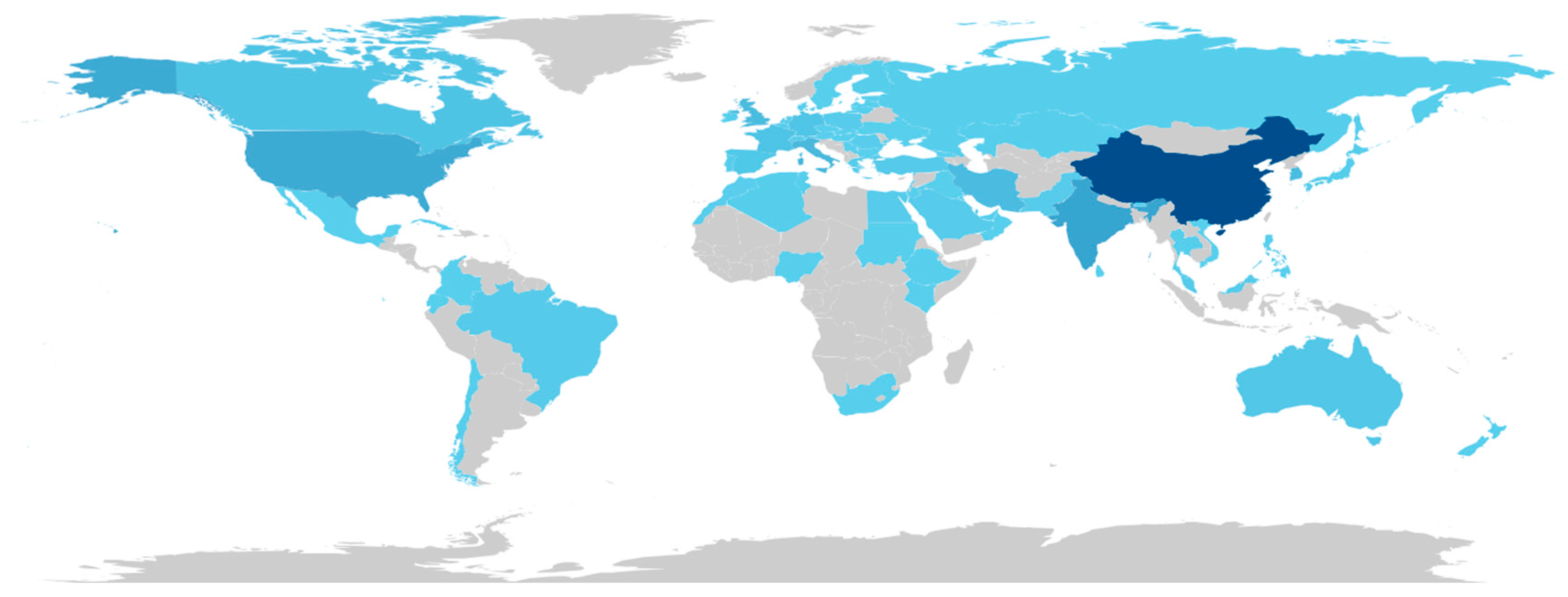

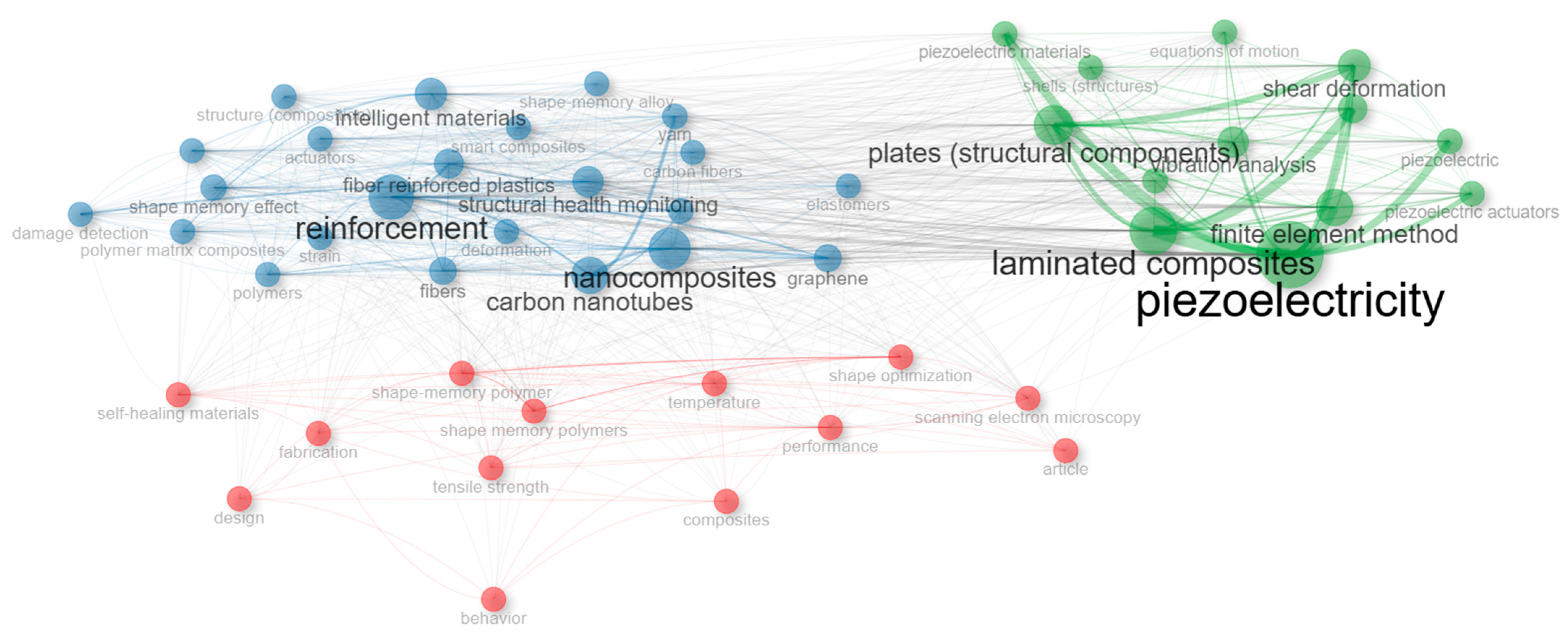
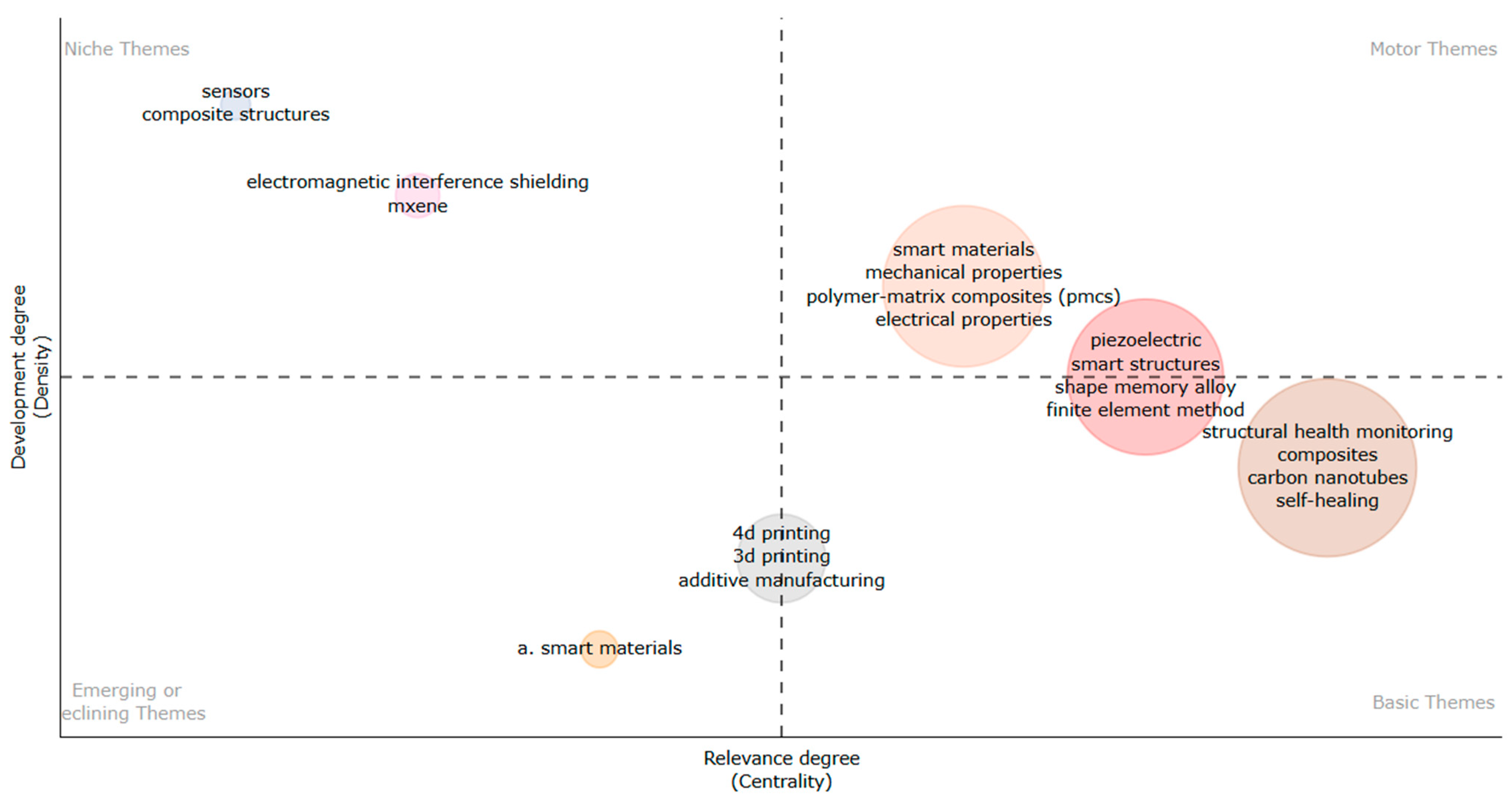
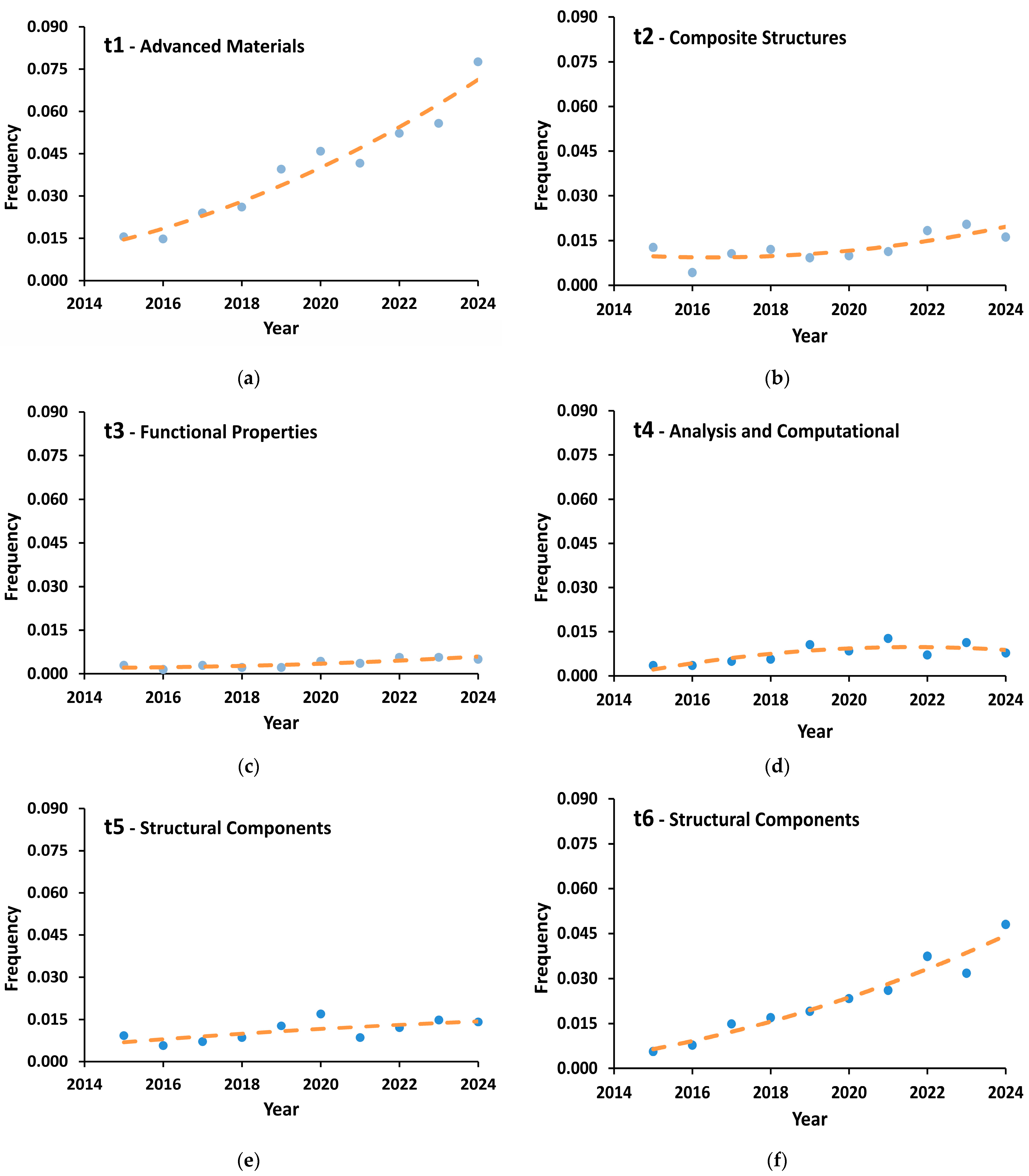
| Scientific Journal | h_Index | g_Index | m_Index | TC | NP | PY_Start |
|---|---|---|---|---|---|---|
| Composites Science and Technology | 31 | 49 | 2.81 | 2667 | 76 | 2015 |
| Composites Part B: Engineering | 29 | 45 | 2.63 | 2119 | 57 | 2015 |
| Composite Structures | 28 | 45 | 2.54 | 2573 | 99 | 2015 |
| ACS Applied Materials and Interfaces | 19 | 29 | 1.72 | 1998 | 29 | 2015 |
| Composites Part B: Engineering | 19 | 27 | 1.72 | 1303 | 27 | 2015 |
| Smart Materials and Structures | 19 | 29 | 1.72 | 1056 | 63 | 2015 |
| Composites Part A: Applied Science and Manufacturing | 18 | 34 | 1.64 | 1179 | 37 | 2015 |
| Journal of Intelligent Material Systems and Structures | 17 | 24 | 1.55 | 675 | 49 | 2015 |
| Thin-Walled Structures | 16 | 27 | 1.78 | 909 | 27 | 2017 |
| Chemical Engineering Journal | 12 | 19 | 1.50 | 951 | 19 | 2018 |
| Author | h_Index | g_Index | m_Index | TC | NP | PY_Start |
|---|---|---|---|---|---|---|
| Y. Liu | 27 | 73 | 2.455 | 5343 | 77 | 2015 |
| Y. Wang | 25 | 41 | 2.273 | 1875 | 76 | 2015 |
| X. Wang | 19 | 30 | 1.727 | 952 | 43 | 2015 |
| S. Ahn | 18 | 20 | 1.636 | 1290 | 20 | 2015 |
| Y. Chen | 18 | 31 | 1.636 | 1019 | 31 | 2015 |
| J. Leng | 18 | 36 | 1.636 | 1406 | 36 | 2015 |
| L. Guadagno | 16 | 19 | 1.455 | 928 | 19 | 2015 |
| W. Wang | 16 | 24 | 1.455 | 912 | 24 | 2015 |
| J. Yang | 16 | 29 | 1.600 | 973 | 29 | 2016 |
| L. Zhang | 16 | 25 | 1.600 | 856 | 25 | 2016 |
| Country | TC | Average Article Citations |
|---|---|---|
| China | 17,761 | 28.10 |
| USA | 3313 | 23.80 |
| India | 2974 | 14.20 |
| Korea | 2316 | 23.90 |
| Italy | 2209 | 22.10 |
| Iran | 2111 | 20.90 |
| Canada | 1421 | 26.80 |
| Reference | Authors | TC | TC per Year | Normalized TC |
|---|---|---|---|---|
| [26] | J. Liu et al. | 1468 | 163.11 | 30.32 |
| [27] | Z. Xun Khoo et al. | 762 | 69.27 | 19.02 |
| [28] | Z. Ma et al. | 647 | 107.83 | 18.52 |
| [29] | G. Zhan Lum et al. | 499 | 49.9 | 11.36 |
| [30] | H. Wei et al. | 415 | 46.11 | 8.57 |
| [31] | Q. Mu et al. | 361 | 40.11 | 7.46 |
| [32] | Y. Wan et al. | 337 | 42.13 | 9.85 |
| [33] | Z. Fan el al. | 333 | 55.50 | 9.53 |
| [34] | A. Jain et al. | 324 | 29.45 | 8.09 |
| [35] | F. Guo et al. | 280 | 35 | 8.19 |
| Denomination | Research Topic | Keywords | Results n (%) |
|---|---|---|---|
| t1 | Advanced materials | Nanocomposites, carbon nanotubes, graphene, fibers and fiber reinforced plastics | 580 (29.7%) |
| t2 | Composite structures | Laminated composites, composite structures, laminating and reinforcement | 179 (9.2%) |
| t3 | Functional properties | Piezoelectricity, shape memory effect and intelligent materials | 51 (2.6%) |
| t4 | Analysis and computational methods | Finite element method, shear deformation and vibration analysis | 108 (5.5%) |
| t5 | Structural components | Plates (structural components) and actuators | 159 (8.1%) |
| t6 | Monitoring and performance | Structural health monitoring and performance | 340 (17.4%) |
Disclaimer/Publisher’s Note: The statements, opinions and data contained in all publications are solely those of the individual author(s) and contributor(s) and not of MDPI and/or the editor(s). MDPI and/or the editor(s) disclaim responsibility for any injury to people or property resulting from any ideas, methods, instructions or products referred to in the content. |
© 2025 by the authors. Licensee MDPI, Basel, Switzerland. This article is an open access article distributed under the terms and conditions of the Creative Commons Attribution (CC BY) license (https://creativecommons.org/licenses/by/4.0/).
Share and Cite
del Bosque, A.; Vergara, D.; Fernández-Arias, P. An Overview of Smart Composites for the Aerospace Sector. Appl. Sci. 2025, 15, 2986. https://doi.org/10.3390/app15062986
del Bosque A, Vergara D, Fernández-Arias P. An Overview of Smart Composites for the Aerospace Sector. Applied Sciences. 2025; 15(6):2986. https://doi.org/10.3390/app15062986
Chicago/Turabian Styledel Bosque, Antonio, Diego Vergara, and Pablo Fernández-Arias. 2025. "An Overview of Smart Composites for the Aerospace Sector" Applied Sciences 15, no. 6: 2986. https://doi.org/10.3390/app15062986
APA Styledel Bosque, A., Vergara, D., & Fernández-Arias, P. (2025). An Overview of Smart Composites for the Aerospace Sector. Applied Sciences, 15(6), 2986. https://doi.org/10.3390/app15062986








